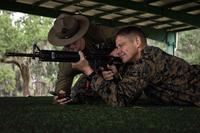Army Chief of Staff Gen. Ray Odierno announced Thursday that Army, Marine Corps and Special Operations Command officials are working together to stand up the Office of Strategic Landpower to evaluate how the U.S. military's ground forces will transition within the new defense strategy and the pivot to the Pacific.
The Air Sea Battle concept has dominated discussions about the Defense Department's transition from the wars in Iraq and Afghanistan to the Pacific. Air Sea Battle is a strategy in which the Pentagon can meld power projection assets such as a carrier group or long range bombers to influence a region without having a large footprint directly inside it.
Led by the Air Force and Navy, national security leaders have made clear the two services will require additional forces to execute Air Sea Battle strategies. More importantly, Air Sea Battle is expected to carry additional influence when it comes time to divide the Pentagon's budget.
U.S. Army leaders did not hide their frustration with the lack of discussion of the Army's role within Air Sea Battle -- especially as 60,000 soldiers remain deployed to Afghanistan -- at the Association of the U.S. Army's annual conference. In many ways, the Office of Strategic Landpower, sounds like the Army's answer to Air Sea Battle.
The office has not been established yet, but Odierno said he expects leaders inside the office to evaluate what roles ground forces will play in "future conflicts." Odierno spoke Thursday at the Center for Strategic and International Studies, a Washington think tank. He warned those in attendance of the negative consequences if you "assume away the need for ground force capability."
"I think that's a dangerous road for us to go down," Odierno said.
Army leaders made their case for the need for the Army within the new defense strategy saying "presence" wins wars.
“Preventing conflict demands presence, shaping the environment demands presence, restoring the peace demands presence, and more often than not, that presence proudly wears the uniform of an American soldier,” Odierno said Oct. 23.
Army Secretary John McHugh said the Army holds key positions in the Air Sea Battle office. Deputy Defense Secretary Ash Carter confirmed that the Army will "have a major role in each of the tenets of the new [defense] strategy."
However, the Army remains nervous over its footing in the pivot to the Pacific, especially as Congress plans to continue cutting the defend budget. Although Odierno said it was justified after the Army experienced the greatest amount of growth over the past decade, the Army still absorbed more than half the cuts to the Pentagon's 2013 budget.
As Odierno explained at AUSA, he anticipates the Army must prepare to engage a range of threats across a wide spectrum to include “regular warfare, irregular warfare, terrorism, and criminality all combined together."
Like it did in Iraq and Afghanistan, the Army will work closely with the Marine Corps and Special Operations Command to engage those threats.
The buzz word that circulates the halls of the Pentagon is "A2AD," or anti-access anti-denial. It has been for the past two years since Air Sea Battle was stood up and Pentagon officials started to consider a military that wasn't fighting two simultaneous wars in Iraq and Afghanistan.
Army officers have explored how their service will execute A2AD scenarios. Odierno said the 18th Airborne Corps will focus on defining how the Army will operate in forcible entry missions. However, he made sure to emphasize that the Army holds a major role within those scenarios.
"You can't achieve, in my opinion, A2AD with just air and sea," Odierno said.







